Thomas May's Blog, page 13
May 23, 2024
Extreme States: Yuja Wang’s Kaleidoscopic Recital in Seattle
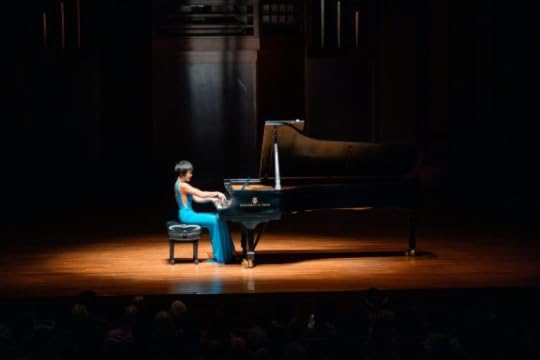 Yuja Wang presented by Seattle Symphony at Benaroya Hall © Brandon Patoc
Yuja Wang presented by Seattle Symphony at Benaroya Hall © Brandon PatocMy review of Yuja Wang’s recital at Benaroya Hall last Friday evening has been posted here:
It would be facile to suggest that the program Yuja Wang chose for her North American tour this spring was intended to display her astounding versatility – a versatility that is merely one manifestation of the artist’s virtuoso showmanship….
May 18, 2024
Gemma New’s Welcome Return to Seattle
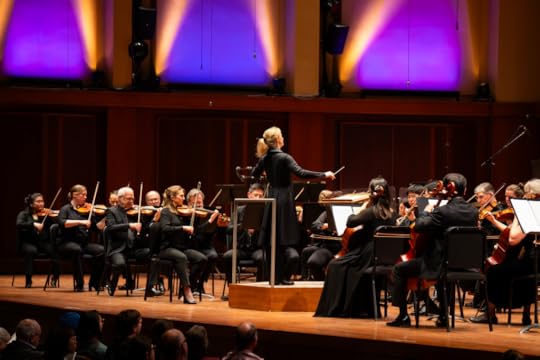 Gemma New with Seattle Symphony; photo (c) Ben VanHouten
Gemma New with Seattle Symphony; photo (c) Ben VanHoutenA few weeks ago, Gemma New led the Seattle Symphony in an interestingly unusual program centered around Vaughan Williams’s Antarctic Symphony. The New Zealand-born conductor made an unexpected return visit this past week, when she agreed to take on another guest program in lieu of Elim Chan, who had been originally scheduled to make her debut with the orchestra but canceled owing to a family emergency.
New had just the week before stepped in for Marta Gardolińska at San Francisco Symphony — where, as in Seattle, she took on the program that had been announced, with no changes. That remarkable confirmation of New’s versatility and grace under pressure enhances her already impressive profile.
Thus New opened the first night of Seattle Symphony’s program (17 May) with a contemporary piece she had to learn under extra pressure: Unsuk Chin’s Subito con forza. The piece — so texture- and idea-rich that the term “concert opener” really doesn’t do it justice — was one of the many commissions around the (ill-fated) Beethoven anniversary year in 2020 for compositions reflecting in some way or other on the legacy of Beethoven.
Chin has described Beethoven as “the first consciously modern composer, in the sense that every piece asked for original solutions, even if this meant breaking through existing forms.” She adds: “What particularly appeals to me are the enormous contrasts: from volcanic eruptions to extreme serenity.” Subito con forza — meaning “suddenly, with power,” a phrase in the style of a Beethovenian musical indication such as “Allegro con brio” for the first movement of the Fifth Symphony — abounds in eruptions and contrasts. The opening gesture, for example, alludes to the Coriolan Overture and then explodes into a parallel but unfamiliar universe of chiming percussion and extended technique and quickly gutters into ghostly shiverings on the strings.
Seeming to explore untapped potential or multiple other directions Beethoven might have followed with his raw material, Chin’s approach differs in fascinating ways from Jörg Widmann’s Beethoven homage Con brio. New elicited a sense of the incandescent fire of Chin’s imagination, harnessed through the composer’s formidable orchestral technique.
It made for a wonderful companion piece to the second half of the program, the Symphony No. 1 by Beethoven himself. The audience was treated to an engrossingly fresh account that conjured a sense of the young composer bursting with ideas and the passion to stake his claim. New avoided the temptation to play up Beethoven as an eccentric flouting convention, which made his surprise moves in this work all the more effective, from the harmonic detour of the opening measures and the dam-rupturing energy of the extended coda in the first movement to the teasing, step-by-step presentation of the finale’s main theme.
The conductor’s style of sweeping, balletic gestures signaled the mellifluous, fully layered sound she elicited from the orchestra, with careful attention to dynamics and inner lines, but nothing over-polite or smoothed over. New was particularly sympathetic to the wit and humor of Beethoven’s First and — abetted by the Benaroya Hall acoustic — emphasized a somewhat brighter sonority overall, with Alexander White’s trumpet part always clearly discernible. She aligned the double basses in a curious configuration on stage left, divided into two subsections stretching to the wall. I couldn’t quite notice a difference in the sound, but I assume it supported a particular balance she was looking for. New left a vivid impression of having something to say with this familiar rep, and I’m eager to hear more Beethoven from her.
 James Ehnes and Gemma New with Seattle Symphony; photo (c) Ben VanHouten
James Ehnes and Gemma New with Seattle Symphony; photo (c) Ben VanHoutenThe program also offered an account of the Samuel Barber Violin Concerto featuring Jame Ehnes, one of the piece’s most eloquent advocates today. Any chance to hear Ehnes is to be cherished, but this performance struck me as particularly special, with the violinist adding a darker perspective to the work than I’ve heard before. The unwavering technique and consistently beautiful phrasing were there, but Ehnes touched on a more tragic than consoling aspect to Barber’s long-limbed lyricism.
Oboist Ben Hausmann — who also deserves kudos for his significant role in the Beethoven symphony — set the tone for the Andante with a solo of heartrending sincerity, while Ehnes countered with a melody of his own that seemed to have been generated in the moment. The Andante also allowed him to display the full richness of his 1715 “Marsick” Stradivari’s lower range. The frenzied virtuosity of the brief, perpetual-motion finale takes a drastically different turn from the preceding movements but felt like a necessary counterpart to so much lyrical effusion. New gave the orchestra a good deal of leeway, which, aside from a few issues of balance, encouraged an especially engaging rapport with the soloist.
Ehnes offered a substantial encore with his account of Eugène Ysaÿe’s single-movement Sonata No. 3 in D minor for solo violin, matching passion with flawless technique for this music clearly close to his heart.
Review (c) 2024 Thomas May
May 16, 2024
“Before It All Goes Dark”
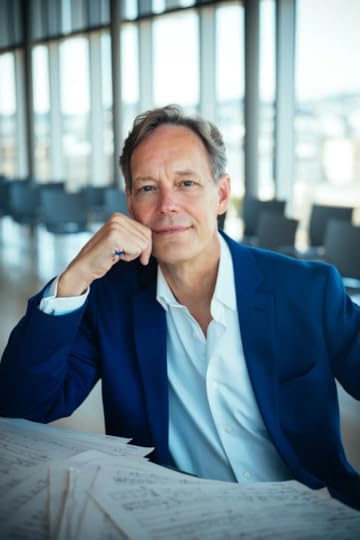 Jake Heggie, composer of “Before It All Goes Dark,” a one-act opera based on the real-life story of an American veteran who learns he is heir to artworks looted by the Nazis. (James Niebuhr)
Jake Heggie, composer of “Before It All Goes Dark,” a one-act opera based on the real-life story of an American veteran who learns he is heir to artworks looted by the Nazis. (James Niebuhr)My Seattle Times preview of Jake Heggie’s latest stagework, a one-act chamber opera commissioned by Music of Remembrance that will be premiered this Sunday 18 May:
Jake Heggie can never predict where he will find the topic for his next opera. But the American composer has an instinct for recognizing when he has alighted on a story that will send his imagination into overdrive. ..
May 8, 2024
Striking Gold in Seattle
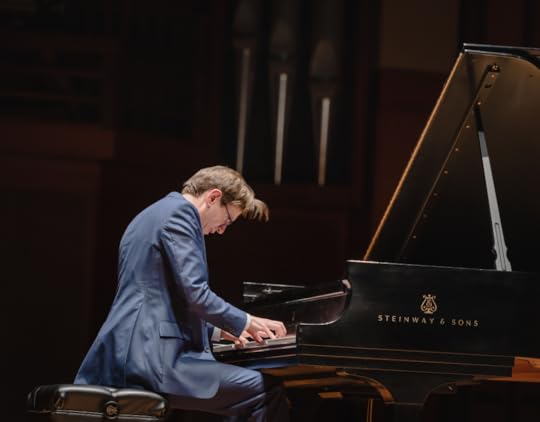 Víkingur Ólafsson; photo (c) Carlin Ma
Víkingur Ólafsson; photo (c) Carlin MaWrapping up a rich and lively weekend of music in Seattle, Víkingur Ólafsson paid a visit to Benaroya Hall on Sunday afternoon May 4 for a program solely devoted to J.S. Bach’s “Keyboard exercise, consisting of an ARIA with diverse variations for a harpsichord with two manuals” — or, as posterity knows the work, the Goldberg Variations.
Seattle was the latest stop on the Icelandic pianist’s current world tour of the work, which comprises no fewer than 88 concerts, in homage to the number of keys on the modern piano (quite a few more than the 54 keys of Bartolomeo Cristofori’s original “gravicembalo” or the 60-something keys Bach was used to when playing one of his harpsichords).
As Ólafsson explained to the culture journalist Paul Hodgins, the fact that he turned 40 this year inspired him to think up “thinking that I wanted to have a “a different kind of touring season. I thought, ‘What if I do a whole world tour with the Goldberg Variations and challenge myself, hopefully to keep renewing myself and finding … new truth in this work — do 88 variations on these 30 variations and try to try to find something unique each night?’” In reality, demand has been so high that Ólafsson has ended up extending the number up into the 90s.
But once the Seattle audience had settled into place — an impressively large gathering for a solo recital on a Sunday afternoon — and the boyish-looking Ólafsson strolled out onto the lonely stage, it was as if he were confronting his awe at this colossal monument for the first time.
Nothing could have been further removed from the routine or predictable. Even though the basic outlines of his interpretation of the Goldbergs are available from the DG recording he released last October — coming in at about 74 minutes total — he radiated such presence and intensity in this live performance that he gave the impression he had only just arrived at his understanding of the work and its interconnections.
Indeed, it would be fascinating to compile the pianist’s observations throughout his odyssey, following each performance, of what struck him as unique or different in that particular iteration, in that specific exchange with the audience.
At the same time, the signatures of Ólafsson’s style were there, presented with compelling grace and concentration. His first statement of the Aria was like gifting a troubled world with an object of pellucid, crystalline beauty, each note value and ornament having its raison d’être. Throughout, Ólafsson chose subtle rather than flamboyant alterations in the repeats — variations of the variations — that heightened the sense of mindful attention his performance encouraged.
But there was no dearth of drama, signaled already by the leap into Variation 1, following the mood carefully established by his phrasing of the Aria: an abrupt intrusion of velocity that audibly took the breath of some in the audience. As if to say that the peaceful quietus mimicked by the final cadence of the Aria’s return in its first statement was an illusion, now the business of living begins, the whirlwind of experience.
I could single out numerous specific reactions and associations set loose by each station on Ólafsson’s journey — that overused metaphor for music-in-action, virtually impossible to avoid in this case. His way of slowly dialing up the weight of a bass line on its return, the exuberant, life-affirming trills of Variation 14, the shock of the first turn to a full variation in the minor in No. 15, itself dwarfed by the seemingly inextricable situation of tragedy in the Adagio Variation No. 25 — Wanda Landowska’s famous “black pearl” — which, in Ólafsson’s hands, fell just short of ten minutes by the clock but seemed an eternity of wandering in a labyrinth of grief.
I’m well aware of the critiques of Ólafsson — not a few of which seem to make a great deal out of the non-musical topic of the photo essay accompanying the DG recording, with its mannered poses and hand displays waiting for a contemporary Rodin to sculpt. It’s no surprise that Bach’s 1741 masterpiece provokes such intense and contradictory responses and defenses. This is a work that reminds us of what is really at stake when music matters.
For my part, I failed to see Ólafsson’s choices as a display of self-indulgence or arbitrary exaggeration. Instead, I was won over by his ability to encompass so many shades of emotion and states of being while deploying the most extraordinary technique. I relished his deeply songful legato lines and transformation of toccata display into unfettered joy. With his magician-like hand-crossing and suspended right-hand gestures, the visual dimension also fascinated. My only question, not even necessarily a quibble, was the degree to which Ólafsson seemed to rely on the pedal for his legato bliss and tonal mixings.
The Quodlibet was vigorous and hearty, but instead of leading to the moment of final reassurance, the Aria’s return came shrouded in melancholy or even a touch of disbelief — is this all our experience amounts to? Unlike Marx’s notion of recurrence a second time as “farce,” Ólafsson’s has spoken of the Aria’s comeback as a tragic moment: “And that’s what (we feel) collectively when we have that moment together. The aria comes back, and then we lose it again. It’s one of the most tragic moments in music. Not because the music sounds so tragic, but because we feel our own impending death. It is going on without us.”
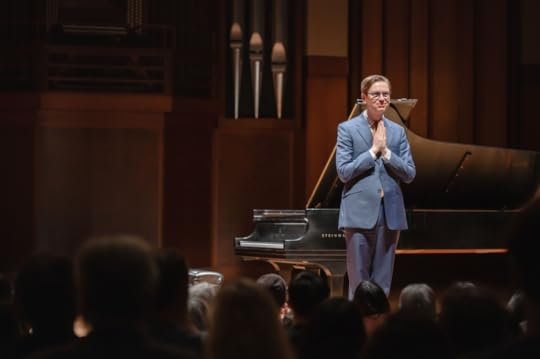 photo (c) Carlin Ma
photo (c) Carlin MaYet there is optimism in the endurance of Bach’s own work, which the Thomas Cantor described as “composed for connoisseurs, for the refreshment of their spirits.” Ólafsson, in his essay accompanying the album, resorts to the metaphor of “a grand oak tree, no less magnificent, but somehow organic, living and vibrant, its forms both responsive and regenerative, its leaves constantly unfurling to produce musical oxygen for its admirers through some metaphysical, time-bending photosynthesis.”
At the end of it all, Ólafsson acknowledged the several rounds of applause with self-effacing sincerity, pointing gratefully to the Steinway. With no apparent depletion of the energy with which he had first beelined his way there an hour and a quarter before, he explained why an encore simply wasn’t in the works (though I’ve seen reports of an occasional encore offered in other venues on this tour): “There’s already an encore built into the Goldbergs, with the repeat of the Aria. And if I played that again, I’d have to continue with the first variation, and the second, and … We’d still be here for awhile….”
Ólafsson also mentioned how happy he was to be in Seattle, since it have him a chance to reunite with a former classmate at Juilliard who had been a source of inspiration: Seattle Symphony concertmaster Noah Geller.
A couple days before, on Friday evening (May 2), Geller had been in the spotlight as the curator and featured artist of the SSO program Noah Geller’s Playlist — the last in a new series this season that has also featured such artists as Mahani Teave and Conrad Tao.
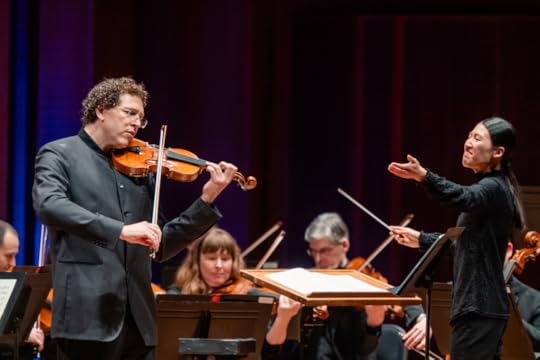 Noah Geller with the Seattle Symphony and conductor Sunny Xia; photo (c) Brandon Patoc
Noah Geller with the Seattle Symphony and conductor Sunny Xia; photo (c) Brandon PatocPlayed without intermission and with SSO reduced to a chamber size ensemble, the concert was filled with delights from start to finish — and offered yet more music of Bach. Geller was joined by principal second violinist Elisa Barston as co-soloist in Bach’s Double Violin Concerto in D minor, BWV 1043 — which Geller characterized as “the happiest that D minor has ever been made to sound.” The highlight of their account was the lyrically urgent Largo (in F major), while the fast outer movements flowed with overlapping waves of energy.
If Bach creates the illusion of a unified mega-instrument from the two soloists — Geller and Barston playing off each other with stylishly expressive flourishes — the great sonatas and partitas fashion a mirage of plurality from the solo instrument. Geller later played as an encore a heartfelt, deeply touching account of the Andante from Bach’s Sonata No. 2 in A minor for solo violin.
It followed his marvelously satisfying interpretation of the last and most-popular of Mozart’s canonical violin concertos, K. 219 in A major. SSO assistant conductor Sunny Xia elegantly guided the sonic balance. Geller seemed to be revisiting the hallucination of an idyll that had been imagined by his first, quasi-“slow motion” appearance in the opening movement, free this time to ponder its meaning at ecstatic length and singing high above the ensemble voices with sweet but never syrupy tone. He showed swashbuckling virtuosity in particular in the speedy section of the curiously constructed Rondeau finale. The entire piece emanated personality and multifaceted charm.
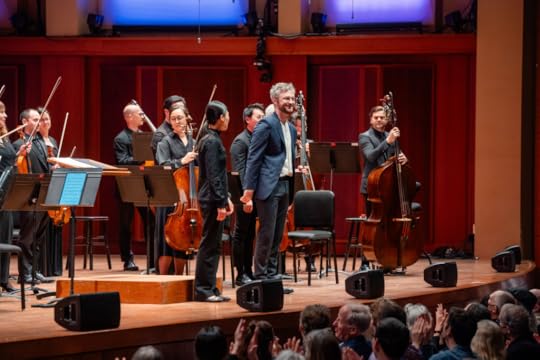 Composer Samuel Carl Adams; photo (c) Brandon Patoc
Composer Samuel Carl Adams; photo (c) Brandon PatocBetween the two repertoire items, Geller selected a new piece by the composer Samuel Carl Adams. Hailing from Berkeley (where his famous father, John Adams, resides), Adams is of late a locally based artist, having moved to Seattle with wife Helen Kim, SSO associate concertmaster. Composed in 2018, Movements (for us and them) is composed for string orchestra with a concertino string quartet (Geller did not perform here).
It was an inspired choice, juxtaposing the shifting textural currents of Bach’s concerto grosso format and Mozart’s solo concerto plot with a richly reimagined drama of single and collective voices. A composer whose textural innovations are matched by a solid understanding of architecture and long-range form, Adams found inspiration in the Italian writer and journalist Italo Calvino’s Six Memos for the New Millennium (planned as part of the Charles Eliot Norton Lectures at Harvard). Movements pulsates with exciting rhythmic layering and polyphonic bounty, reflecting the composer’s desire to explore “cooperation and fluidity” in musical terms.
(c)2024 Thomas May All rights reserved
May 7, 2024
The Ninth at 200
Exactly 200 years ago today, on 7 May 1824 at 7pm Vienna time, Beethoven presented a “Grand Musical Academy” at the Theater am Kärntnertor. On the program: the Overture to The Consecration of the House; selections from the recently premiered (in St. Petersburg) Missa Solemnis (Kyrie, Credo, and Agnus Dei); and “a grand symphony with solo and choral voices entering in the finale, on Schiller’s ‘Ode to Joy'” — as the poster described the Symphony No. 9 in D minor, Op. 125.
From The Ninth: Beethoven and the World in 1824 by the always insightful cultural historian Harvey Sachs:
It was in the works of his last years that Beethoven delved ever more deeply into his subconscious while affirming ever more strenuously the artist’s obligation to use self-revelation as a means toward the achievement of worldwide human harmony. I call this process the universalizing of the intimate. His Missa Solemnis, Ninth Symphony, last three piano sonatas, “Diabelli” Variations for piano, and last five string quartets are above all a search for transcendence. In them, he carried the process of universalizing the intimate as far as and probably farther than any other musician had or has ever done; at the very least — as Maynard Solomon, a lifelong student of the composer’s life and works, has written — in these works Beethoven “forever enlarged the sphere of human experience available to the creative imagination.”
“The question of whether or not we ought to read artists’ lives into their works ceases to matter in Beethoven’s last years. His late works were his life. …”
“In many ways, Beethoven was — is – much more modern than we are. “We live ‘as if,’” says the protagonist of Claire Messud’s novel, The Last Life, “as if we knew why, as if it made sense, as if in living this way we could banish the question and the ‘as if’ness itself, the way we speak and act as if our words could be comprehended […].” Beethoven, in his terrifying isolation and his terrible pride and his unsurpassed capacity to transform experience into organized sound-complexities, went beyond that stage. In the last quartets, and certainly in the Ninth Symphony, he obliterated the ‘as if’ness of comprehension, and then went on to obliterate obliteration — to dance on obliteration’s ashes.”
Thomas May's Blog



